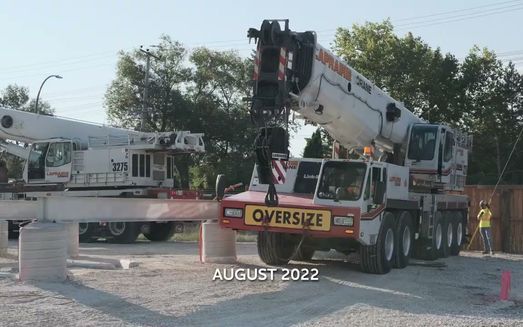Providing Energy for Life means making the most of our equipment and investments to ensure they provide safe, reliable energy to our customers for years to come. Replacing switchgears — in a priority sequence based on data about their risks and failures — is part of our asset management program and represents a significant investment in reliability.
It starts at three in the morning.
Four huge semi trucks, each carrying half a building, drive through Winnipeg — sandwiched between blinking half-tons that say “OVERSIZE LOAD” — and arrive at the University of Manitoba’s Fort Garry campus at about 4:00 a.m. Then the cranes arrive.
This big, early-morning production is part of what it takes to replace the U of M’s switchgear — a building that hosts the 4,160-volt substation-equivalent of an electrical panel and breakers
Trains, cranes, and automobiles: replacing a substation switchgear
About 39 switchgears in Winnipeg need to be replaced, and this is how we do it.
“This is the first of many projects like this we expect to do,” said Dave Van Heyst, a station designer at Manitoba Hydro.
“We’ve done a review of the 60 or so switchgear stations on our system and identified 39 distribution stations where the switchgear needs replacement due to safety concerns and poor condition. The level of investment is estimated at $125 million and will be integrated as part of our larger asset management program,” said Kevin Penner, who oversees asset lifecycle management at Manitoba Hydro.
This switchgear was the first to go because of the safety and reliability concerns it posed. Analysis showed there were 7 major faults in the last 20 years — 3 of which happened in the last 5 years.
“When this type of equipment fails, the high power levels and confined spaces of the design can make for catastrophic failures,” said Maria Neufeld, a director in Operations at Manitoba Hydro. “These failures often involve major arcing, which is a safety hazard to our staff and takes a long time to repair before we can restore power.”
The shiny new switchgear is less prone to failure than its 60-year-old predecessor and has several features built in to enhance safety. It can contain arc blasts much better, but there are also options for staff to remotely interact with the gear to keep themselves out of harm’s way. It’s also a much more spacious workspace and employees no longer need to put on a blast suit to work there.
“This design and project is a great example of the strong culture of safety and cooperation we’ve developed at Manitoba Hydro,” said Dave. “And as with any major transmission or distribution substation project, there are many departments and individuals key to our success.”




